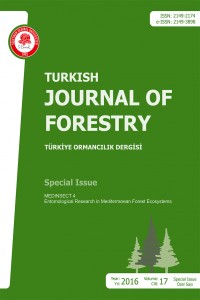Dung beetles (Coleoptera: Scarabaeoideae) between a natural forest and a reforested steppe (Djelfa, Algeria)
Abstract
Steppe ecosystems are characterized by significant biological diversity, and this is the result of a long adaptation process to difficult agro-climatic conditions. Feces of large or small herbivorous animals must be destroyed to be recycled. This process is involving the activity of various soil organisms. Among the most active insects are Scarabaeoidea. Our study was conducted in two grazed ecosystems in djelfa pasture, situated in the semi-arid region; the first one is a pinewood forest, located in the Senalba. The second one is an Aleppo pine reforested stand, part of the Green Dam that was launched decades ago to stop desertification. Dung beetles were captured using baited pitfall traps during the period 2009-2010. 1435 beetles belonging to 42 species were trapped. The faunas of senalba and of Moudjbara were compared. The fauna in the reforested stand is poorer than the one of the natural forest. The natural forest might provide favorable microclimatic conditions for some species such as Chironitis furcifer, Aphodius fimetarius and A. felscheanus. Results showed a significant seasonal variation in the composition, and diversity. There were four periods of activity during the course of the year. Temporal turnover was highest in September and in February, Dungs beetle dominate during summer and autumn in Moudjbara while in the Sénalba they dominate during autumn and winter. This study reveals that natural forest is the most suitable habitat to the installation Scarabaeidae unlike reforestation, this could be the result of a limited grazing in the reforested steppe.
Keywords: Scarabaeoidea, Pinewood forest, Reforested steppe
Keywords
Doğal orman ve yeniden ormanlaştırılmış bozkır alandaki (Djelfa, CEZAYİR) gübre böcekleri (Coleoptera: Scarabaeoideae)
Abstract
Step ekosistemleri, zorlu agro-iklimsel koşullara uyum sağlamak için geçirdikleri uzun adaptasyon süreci sonucunda önemli bir biyolojik çeşitliliğe sahiptir. Büyük ve küçük otobur hayvanların dışkıları bertaraf edilmeli veya geri dönüştürülmelidir. Bu süreç, çeşitli toprak canlılarının faaliyetini içermektedir. Scarabaeoidea familyasında yer alan böcekler, bu süreçte en aktif böceklerden biridir. Çalışmamız, yarı kurak bir alan olan Djelfa otlağında bulunan iki adet otlatma ekosisteminde gerçekleştirilmiştir. Bu ekosistemlerden biri, Senalba bölgesinde yer alan çam ormanıdır. Diğer ekosistem ise, çölleşmeyi durdurmak için yıllar önce başlatılan Green Baraj (Green Dam) projesinin bir parçası olan yeniden ormanlaştırılmış Halep çamı meşceresidir. Gübre böcekleri, 2009-2010 döneminde yemli kapan pusuları ile toplandı. 42 türe ait 1435 tuzakla yakalandı. Senalba ve Moudjbara faunaları karşılaştırıldı. Yeniden ormanlaştırılmış meşcere doğal ormandaki faunadan daha zayıf bir faunaya sahiptir. Doğal orman, Chironitis furcifer, Aphodius fimetarius ve A. felscheanus gibi bazı türler için daha elverişli mikroiklimsel koşullar sağlayabilir. Çalışmanın sonuçları, yapı ve çeşitlilik açısından önemli mevsimsel değişimlerin olduğunu göstermiştir. Yıl içerisinde dört faaliyet dönemi tespit edilmiştir. Zamansal değişim oranı eylül ve şubat aylarında en yüksek seviyeye ulaşmıştır. Gübre böcekleri yaz ve sonbahar aylarında Moudjbara bölgesinde yoğunlaşırken Sénalba bölgesinde sonbahar ve kış aylarında yoğunlaşmıştır. Bu çalışma, yeniden ormanlaştırılmış bölgenin aksine doğal ormanın Scarabaeidae için en uygun habitat olduğunu göstermektedir. Bu durum yeniden ormanlaştırılmış bozkır alanda sınırlı otlama imkânının bir sonucu olabilir.
Anahtar kelimeler: Scarabaeoidea, Çam ormanı, Yeniden ormanlaştırılmış bozkır
Keywords
Details
| Primary Language | English |
|---|---|
| Journal Section | Orijinal Araştırma Makalesi |
| Authors | |
| Publication Date | May 10, 2016 |
| Published in Issue | Year 2016 Vol 17 Special Issue |


